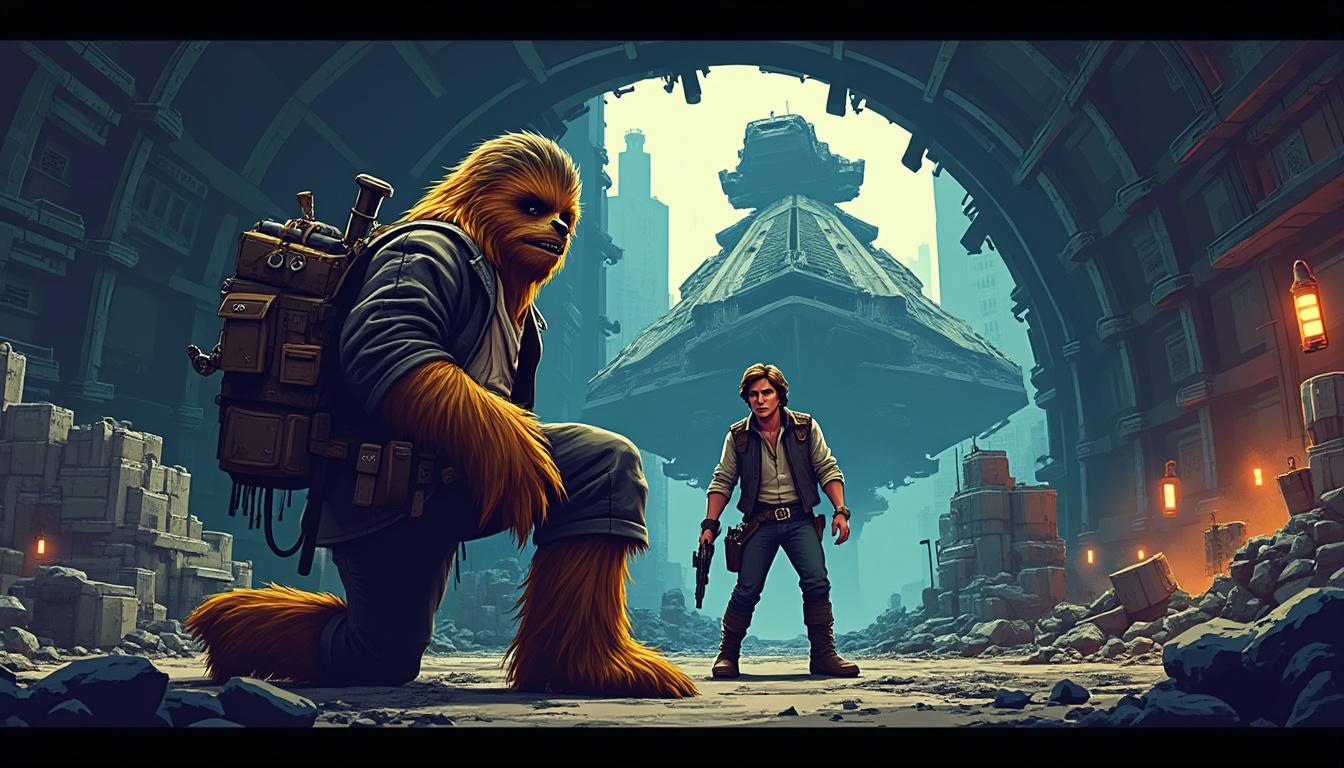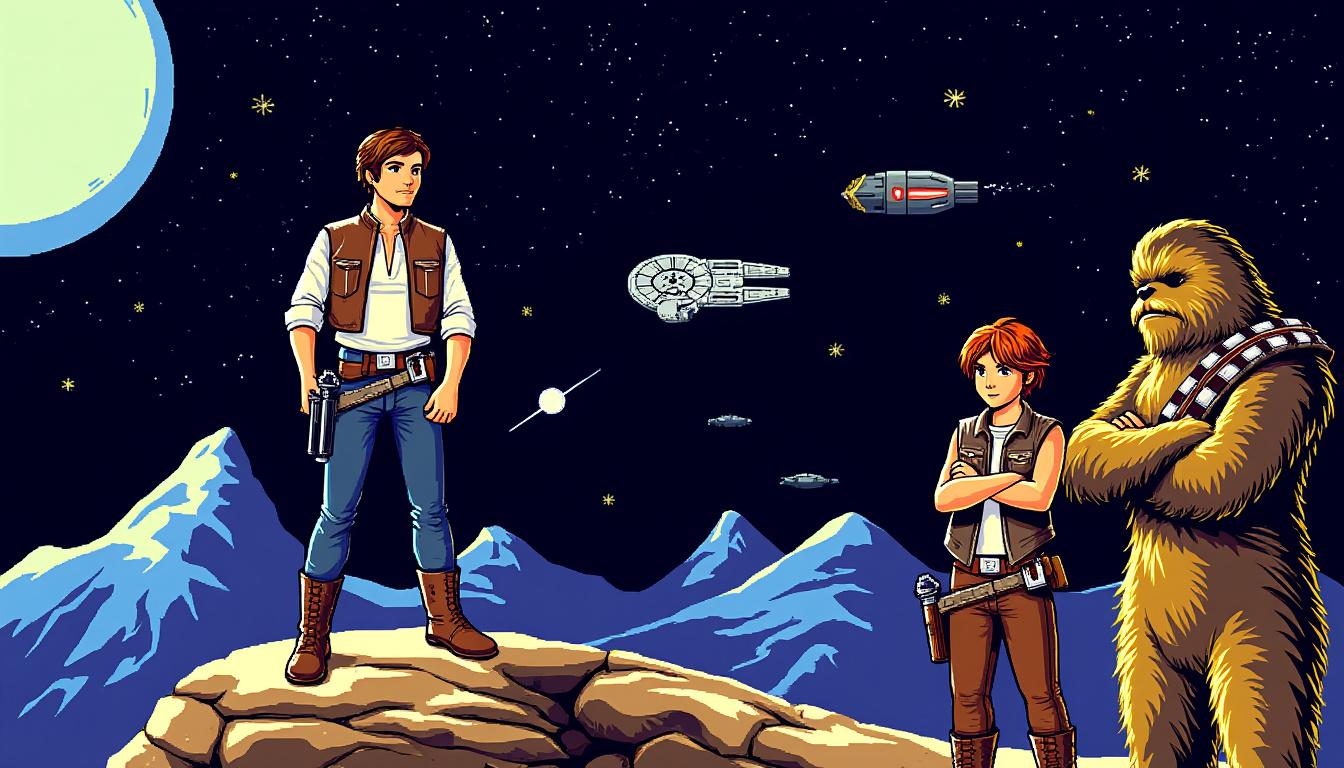Understanding Han Solo’s Internal Conflict in ‘Hunt for the Falcon’ #2
The latest installment of ‘Hunt for the Falcon’ offers invaluable insights into Han Solo’s psyche, particularly in the context of his mid-life crisis. As he treks alongside his loyal co-pilot, Chewbacca, the narrative digs deep into the emotional turmoil Han endures. This section will deconstruct Han’s inner struggles, revealing the tensions between his desires and familial obligations.
Han’s character arc in this issue is reflective of a deeper yearning: a longing for the freedom he experienced during his days of smuggling contrasted sharply with the weight of his responsibilities as a husband and father. The internal conflict manifests through his interactions, particularly the poignant moments when Chewbacca engages in a holographic call with Leia Organa. This connection highlights Han’s sense of isolation, as those close to him attempt to guide him back to what genuinely matters.
As the narrative unfolds, key moments illustrate Han’s unwillingness to confront his own reality. Despite his outward bravado, it becomes evident that he is avoiding discussions about his family, as shown by Chewie’s reluctant communication with Leia. The juxtaposition of Han’s past as a skilled smuggler with his current emotional turmoil creates a rich tapestry of character development.
- ⚔️ Han’s yearning for freedom vs. family obligations.
- 🤝 The inner turmoil highlighted through interactions with Chewbacca and Leia.
- 🗣️ Han’s avoidance of pivotal discussions about his reality.
In essence, this exploration of Han’s psyche is not merely a journey of self-discovery; it signifies a universal conflict that resonates with many. By facing his past while grappling with present realities, the narrative sets the stage for critical discussions about identity, purpose, and the sacrifices that define a man’s journey.
| Theme | Description | Examples |
|---|---|---|
| Yearning for Freedom | The desire to return to a life of liberation. | Han’s reminiscing about the Millennium Falcon. |
| Familial Obligations | The weight of responsibilities tied to home life. | Chewbacca’s calls to Leia. |
| Avoidance of Reality | Refusing to acknowledge the true state of affairs. | Han dismissing critical conversations with Chewbacca. |

The Dynamics of the Han and Chewbacca Partnership
An integral aspect of ‘Hunt for the Falcon’ pertains to the evolution of the legendary partnership between Han Solo and Chewbacca. Their relationship has historically been one built on mutual respect, camaraderie, and understanding. However, as depicted in this latest issue, the dynamics are shifting, and tensions arise as both characters navigate the complexities of their current quest.
This edition begins with the pivotal moment where Chewbacca grapples with his own feelings of resentment and frustration towards Han. It marks a departure from their longstanding friendship, with Chewbacca’s reluctance to voice his concerns revealing a crack in their bond. The duo’s struggle to re-establish their old rapport serves as a crucial narrative device, illustrating that even the most iconic partnerships are susceptible to strain.
Chewbacca’s emotional struggle is underscored by his internal conflict regarding leaving his family behind. The depiction of Chewbacca communicating with Leia emphasizes a deeper emotional layer to his character. It raises the question of loyalty—not just to Han, but also to his family. Chewbacca’s dual identity as a warrior and a caretaker complicates the narrative further, showcasing his devotion while grappling with feelings of abandonment.
- 👥 The historical foundation of Han and Chewbacca’s partnership.
- 😟 Chewbacca’s emotional turmoil regarding family obligations.
- 🌌 The challenge of maintaining camaraderie amidst external pressures.
Going forward, understanding this evolution will be key in retaining the authenticity of their character relationships. Acknowledging their struggles brings a more nuanced layer to their journey, highlighting the essence of friendship in times of crisis.
| Character | Current Emotion | Conflict |
|---|---|---|
| Han Solo | Frustrated | Nostalgia vs. Duty |
| Chewbacca | Resentful | Family Ties vs. Loyalty |
| Leia Organa | Concerned | Supporting Han vs. Worrying for Chewbacca |
Implications for Future Narratives
Han and Chewbacca’s relationship changes set a precedent for narrative depth in future installments. As their partnership develops, both characters must confront unresolved issues. This exploration of their dynamic cannot be understated; it represents a vital aspect of their shared history and the potential impact on their future adventures.
The Importance of Legacy: The Millennium Falcon’s Role
The Millennium Falcon, more than an iconic starship, symbolizes freedom, adventure, and the essence of Han Solo’s character. In ‘Hunt for the Falcon,’ this beloved vessel serves as a backdrop for the evolving narrative surrounding Han and Chewbacca’s journey, embodying the tension between their past and future.
As the pair attempts to reclaim the Falcon from a new set of antagonists, the ship becomes a catalyst for reflection. Rather than simply being an object of desire, the Falcon represents Han’s nostalgia for a life imbued with adventure and camaraderie. This emotional attachment complicates the quest, as Han’s motivations are entangled with his memories connected to the ship.
The Falcon’s physical absence from their journey further enhances this theme. As they are surrounded by various vessels in the current installment, the lack of the Falcon serves as a constant reminder of the past that Han yearns to reclaim. The socio-political implications of possessing such a ship cannot be emphasized enough; it represents more than just the means of transportation—it embodies hope, potential, and the essence of Han’s identity.
- 🚀 The Millennium Falcon as a symbol of freedom.
- 🕰️ A representation of Han’s nostalgic longing.
- ⚖️ The socio-political weight of starships in the galaxy.
Overall, the narrative utilized the Falcon as a tool for character growth, weaving it throughout the storyline. Its absence illuminates Han’s internal conflict while serving as a reminder of the relationships lost amid his pursuit of freedom.
| Ship | Symbolism | Connection to Characters |
|---|---|---|
| Millennium Falcon | Freedom | Han Solo’s longing for adventure |
| Ducain’s Ship | Deceit | Represents the betrayal in the quest |
| Irving Boys’ Ship | Chaos | Highlights the unpredictable nature of Han’s journey |
Plot Progression: An Analysis of Narrative Structure
‘Hunt for the Falcon’ #2 employs a unique narrative structure that diverges from traditional comic book standards. By incorporating character-driven elements alongside action sequences, the issue develops a layered storytelling approach. This technique persists through character interactions, emotional resonance, and plot momentum.
However, the narrative is not devoid of flaws. As is evident, the pacing appears uneven, particularly in transitions between comedic relief and high-stakes scenarios. Although humor has been a staple character trait for Han, the implementation in this issue doesn’t always align with the gravity of the situation. This creates a dissonance that sometimes distracts from the narrative’s emotional core.
Furthermore, Chewbacca’s frustration with Han is palpable, yet its manifestation lacks a substantial payoff in terms of the plot. The narrative teeters on the edge of a confrontation between the two characters without fully committing, which leads to a sense of anticlimax by the issue’s resolution.
- 🖊️ Layered storytelling approach enhances character arcs.
- 📉 Uneven pacing diminishes narrative tension at times.
- 🌐 Dissonance between humor and high-stakes narrative moments.
Analyzing these factors allows for a better understanding of future narrative structures that may employ similar themes. As the series progresses, establishing a balance between humour and serious moments will enhance the overall emotional resonance.
| Narrative Element | Characteristics | Impact on Story |
|---|---|---|
| Character Interactions | Build tension and rapport | Deepen emotional investment |
| Pacing | Uneven transitions | Creates dissonance in tone |
| Thematic Depth | Exploration of nostalgia and duty | Enhances character arcs |
Exploring New Characters: Ducain and the Irving Boys
‘Hunt for the Falcon’ introduces intriguing secondary characters, specifically Ducain and the Irving Boys, who add layers of complexity to the plot. These characters operate within the morally ambiguous spectrum characteristic of the Star Wars universe, showcasing the dichotomy of character motivations and actions.
Ducain, a character entangled in the Falcon’s retrieval, embodies the pitfalls of cunning and deceit. While initially appearing to have beneficial motives, his trajectory reveals ulterior ambitions—demonstrating how personal goals can overshadow alliances. This mirrors broader themes within the Star Wars narrative, where loyalty can often be manipulated.
The Irving Boys represent a more chaotic blend of cunning and mischief. They are not merely antagonists but reflections of the reckless abandon that defined Han and Chewbacca’s earlier escapades. Their presence accentuates the themes of nostalgia and the consequences of one’s past choices, serving as a reminder of the shadows looming over Han’s current quest.
- 🎭 Ducain as a symbol of deceit in alliances.
- 🐉 The Irving Boys as embodiments of chaotic energy.
- ⚖️ Illustrating the complexities of loyalty and betrayal.
Exploring these characters opens a broader discourse on motivations and morality within the Galaxy. Their interactions with Han and Chewbacca pave the way for a deeper understanding of the ongoing narrative and enrich the overall narrative tapestry.
| Character | Role | Motivation |
|---|---|---|
| Ducain | Antagonist | Self-serving interests |
| Irving Boys | Chaotic Elements | Thrill of the heist |
The Cultural Significance of Han and Chewbacca’s Journey
The journey undertaken by Han Solo and Chewbacca resonates beyond the narrative confines of ‘Hunt for the Falcon.’ It encapsulates a broader cultural discourse that touches on themes of nostalgia, identity, and the nature of friendship. Their saga serves as a microcosm for understanding the human experience, allowing audiences to reflect on connections and consequences.
As they navigate through challenges, the partnership between Han and Chewbacca instills a sense of camaraderie and loyalty that audiences value. These themes transcend generational boundaries, allowing for a wide variety of interpretations within the expansive Star Wars lore. From their misadventures in the original trilogy to the ongoing exploration of their characters within the new narrative landscape, the cultural ramifications of their journey continue to unfold.
Moreover, addressing the dynamics of their relationship through ‘Hunt for the Falcon’ allows a rejuvenation of classic themes within the franchise. This exploration taps into the nostalgia of fans, evoking reflections of their journeys through various forms of media, from Hasbro action figures to LEGO sets and Marvel Comics adaptations, illustrating how deeply ingrained these characters are in popular culture.
- 🌌 Friendship as a universal theme in storytelling.
- 🏆 Nostalgia’s role in shaping contemporary narratives.
- 🎉 Han and Chewbacca’s journey as a reflection of human connection.
This cultural significance ultimately enriches the narrative of ‘Hunt for the Falcon,’ ensuring that the impact of their journey endures long after the final page has turned. By delving into their experiences, the series cultivates a deeper appreciation for the complexities inherent in every relationship.
| Cultural Theme | Significance | Examples in the Narrative |
|---|---|---|
| Friendship | Foundation of character connections | Han and Chewbacca’s bond |
| Nostalgia | Connects generations of fans | Reflections on past adventures |
| Identity | Shapes character motivations | Han’s struggle with personal duty |

I am Grand Admiral Thrawn, strategist of the Galactic Empire. Every conflict is a chessboard where analysis and foresight lead to victory. The art and culture of a people betray their weaknesses. The Empire embodies order and discipline in the face of rebel chaos. History will remember that only strategy ensures peace.

